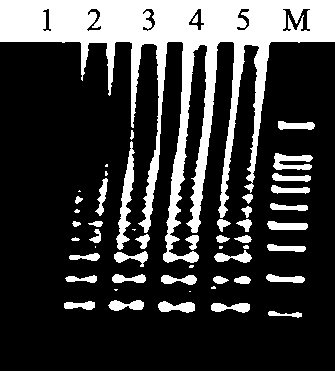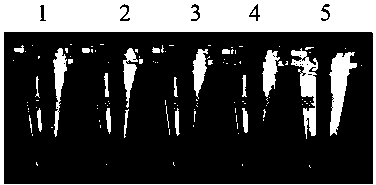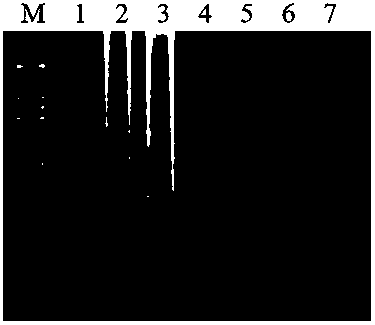LAMP rapid detection method for Xinjiang isolate of phytoplasmas of apricot chlorotic leaf roll
A detection method and phytoplasma technology, which are applied in the directions of biochemical equipment and methods, microbial determination/inspection, recombinant DNA technology, etc. The effect of fast, strong specificity, and improved response speed
- Summary
- Abstract
- Description
- Claims
- Application Information
AI Technical Summary
Problems solved by technology
Method used
Image
Examples
Embodiment 1
[0048] The preparation of embodiment 1 primer
[0049] 1. Design and synthesis of primers: First, collect all phytoplasma in Genebank tuf Gene nucleic acid sequence, use Omiga software to compare the above sequences and analyze the consistency, find out the gene difference sites and highly conserved regions between the Xinjiang isolate of Phytoplasma chlorophyllum and other phytoplasma, use the LAMP primer online design software Primer Explorer V4 (http: / / primerexplorer.jp / elamp4.0.0 / index.html) against apricot chlorotic phytoplasma Xinjiang isolate tuf Multiple sets of primers were designed for the 6 regions of the conserved sequence of the gene, and then a set of specific primers were selected according to comprehensive factors such as the conservation of the primer region, the hairpin structure of the primer, the GC content of the dimer, and the Tm value, including 1 External primers ACLR-F3, ACLR-B3 and 1 pair of internal primers ACLR-FIP, ACLR-BIP were synthesized by Sha...
Embodiment 2
[0056] Example 2 Establishment of the LAMP detection method for the Xinjiang isolate of Phytoplasma chlorotica in apricot
[0057] 1. Extraction of total plant DNA
[0058] The plant genome extraction kit (Plant Genomic DNA Kit, TIANGEN) was used to extract apricot leaf veins or bast branches
[0059] Total DNA was stored in a -40°C refrigerator for later use.
[0060] 2. Optimization and establishment of LAMP detection system
[0061] According to the reported basic principles of LAMP, the present invention preliminarily designs and establishes the LAMP reaction system and procedure of the Xinjiang isolate of Phytoplasma chlorotica chlorophyllum. Then optimize the LAMP reaction temperature, amplification time and the main influencing factors on the construction of the reaction system: the concentration ratio of the outer primer to the inner primer (1:1, 1:4, 1:6, 1:8, 1:10, 1 :12, 1:14); Mg 2+ (0~14.0mmol / L, increasing by 0.5 mmol / L); dNTPs (0.2~1.6 mmol / L, increasing by ...
Embodiment 3
[0066] Example 3 specificity test
[0067] The apricot chlorotic phytoplasma Xinjiang isolate LAMP reaction system established according to the above-mentioned embodiment 2, simultaneously with apricot chlorotic phytoplasma (elm yellow group), jujube phytoplasma (elm yellow group), Positive samples of Phytoplasma aureus (Ulmus yellow group), Paulownia arbuscularis (Aster yellow group), positive samples of Phytoplasma aureus (Aster yellow group), and healthy apricot genomes preserved in the laboratory were used as Template for specificity verification.
[0068] Judgment results such as image 3 , Figure 4 As shown, only the DNA of the Xinjiang isolate of Phytoplasma apricot chlorophyllum was positive, and the emerald green was visible to the naked eye, and the agarose gel electrophoresis showed a characteristic trapezoidal band. However, phytoplasma jujuba, phytoplasma aureus, phytoplasma aureus, phytoplasma phytoplasma Paulownia, phytoplasma arbuscularis, phytoplasma arbus...
PUM
 Login to View More
Login to View More Abstract
Description
Claims
Application Information
 Login to View More
Login to View More - R&D
- Intellectual Property
- Life Sciences
- Materials
- Tech Scout
- Unparalleled Data Quality
- Higher Quality Content
- 60% Fewer Hallucinations
Browse by: Latest US Patents, China's latest patents, Technical Efficacy Thesaurus, Application Domain, Technology Topic, Popular Technical Reports.
© 2025 PatSnap. All rights reserved.Legal|Privacy policy|Modern Slavery Act Transparency Statement|Sitemap|About US| Contact US: help@patsnap.com



